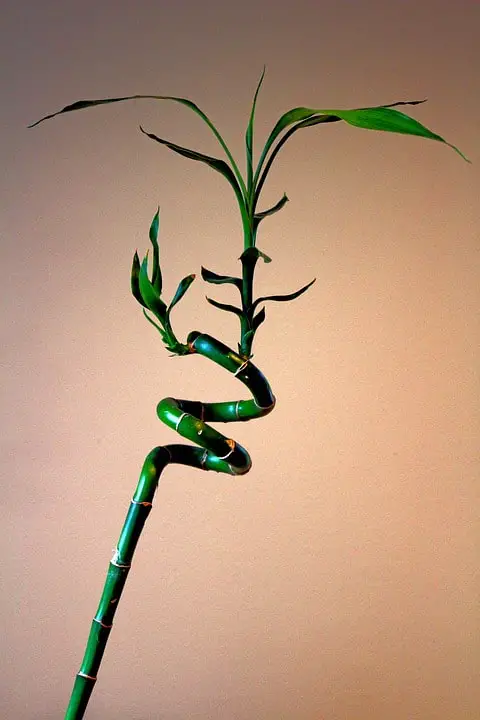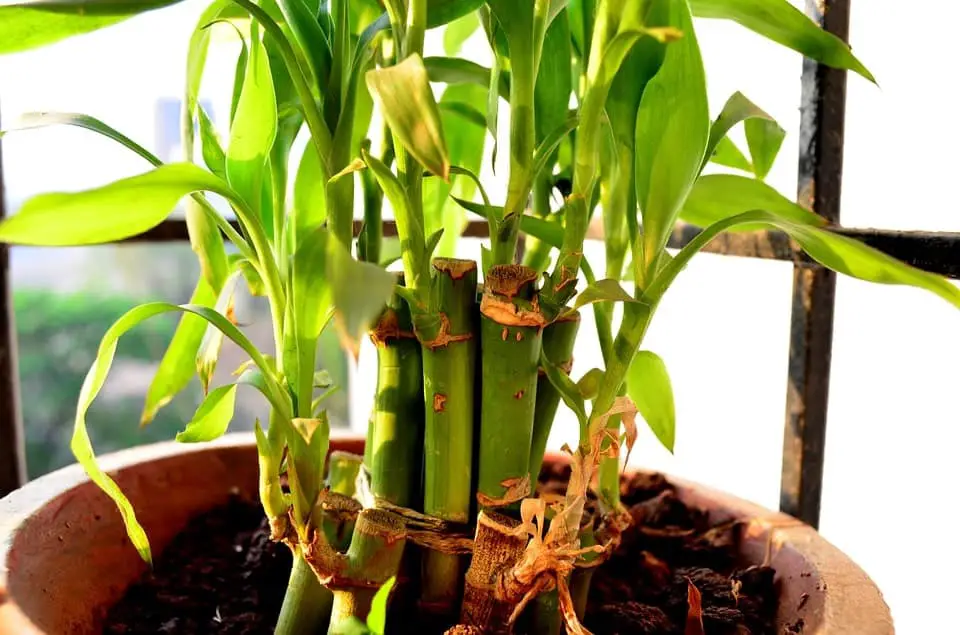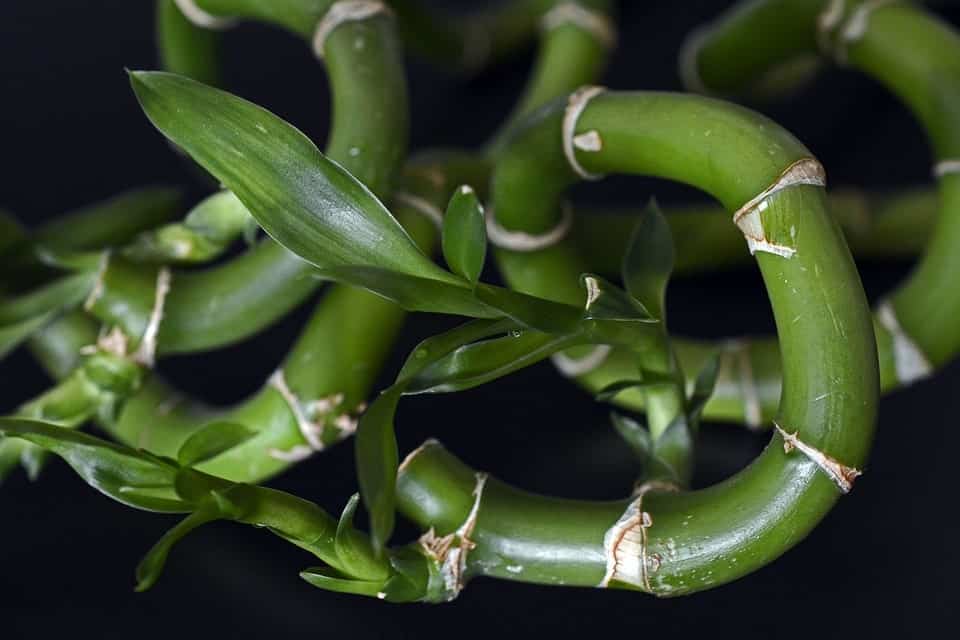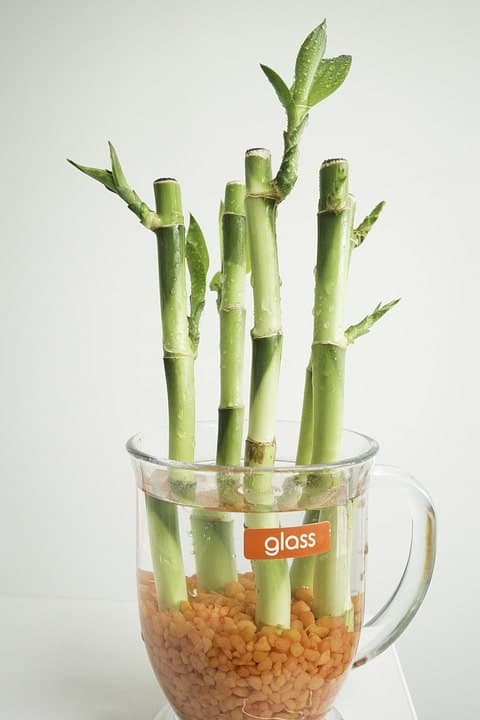How To Grow Lucky Bamboo Plant? For many people, this could be the real deal. The bamboo plant adds a certain amount of charm to your garden with its long canes giving structure and height to the dancing leaves.
This multi-purpose plant is popular all over the world and is quite easy to grow in your garden as well. The lucky bamboo plant, also known as the Chinese bamboo plant, is a different plant species that closely resembles the bamboo.
It is usually kept as an indoor houseplant. Here, we will discuss and try to answer some important concerns related to planting and growing bamboo.
How To Plant Lucky Bamboo Plant In A Pot?
The bamboo plant grows aggressively in the warm climate. So, if you have limited space or live in a colder area, we recommend you plant bamboo in a pot. Let us see how to plant lucky bamboo in the soil step by step.
It is easy to take care of a bamboo plant in a pot if you choose the right species and provide some special care. It is advised to select the smaller varieties if you wish to plant them in a pot.
#1- Pot Choices
It is recommended to choose a solid low-profile pot that has a square base. This provides stability to the tall bamboo plants that are susceptible to damage from strong winds.
You should not opt for thin-walled plastic pots as the bamboo plant will not be able to access groundwater. This can cause unnecessary stress for your plant.
Pick a thick-walled concrete or clay pot instead. This will maintain the moisture and protect the soil and roots.
How to plant bamboo stalks? – While planting, ensure that the stems of your bamboo are straight. If your pot is deep enough, you can also add rocks or gravel at the bottom to assist your plant.
- Read– What are the best ways to prune bamboo plant
- How To Sterilize Soil For Plants Growth [21 Affordable Tips]- Ultimate Guide
#2- Potting Soil
You can buy a premium potting mix. It contains ingredients that enhance water retention and nutrient absorption. Alternatively, you should use only high-quality and well-draining potting soil.
#3- Watering
Regular watering is essential for the growth of this plant, especially during the hot months. The bamboo plant thrives in moist soil. So, they require heavy watering every day during the summer season.
Also, mulching is recommended to prevent the drying of the soil. It is only in the cold months when the plant enters dormancy that you can reduce watering.
Also, read-
- How To Care Lucky Bamboo Plant Turning Yellow- Complete Guide
- How To Get Lucky By Feng Shui Bamboo Placement
How To Grow Lucky Bamboo From Cuttings?
The lucky bamboo is a household plant that has become popular across the world because of its significance in Feng Shui.

What does lucky bamboo look like?
- Though people call this plant lucky bamboo as its stalks or stems resemble bamboo, it is not actually bamboo. It falls in the family of lily plants.
- Also, it has several other popular names such as Dracaena or Dracaena sanderiana. The dracaena or lucky bamboo is indigenous to the African tropical rainforest and some parts of Southeast Asia.
- The lucky bamboo plant care is relatively easy and is more commonly found in homes across the world.
How to grow bamboo from a cutting?
- To propagate the lucky bamboo plant, you should first take a healthy cutting after trimming the mother plant. For propagation, choose the cuttings that have more than one leaf joint.
- Under normal circumstances, you can plant these cuttings as it is. However, if you want to increase its chance of survival, you can add the rooting hormone while planting.
Rooting lucky bamboo in the soil
Rooting stem cuttings of lucky bamboo in the soil is quite easy. As you place the cutting in the fresh potting soil.
Remember to keep at least one root node beneath the soil level. Water regularly and you will see new roots emerging soon.
Does lucky bamboo need soil?
Not necessarily. You can grow this plant in a glass jar filled with distilled water as well.
how to plant lucky bamboo In Water
Place the cutting in distilled water and wait for the new reddish roots to emerge from the bottom of the stalk. Once the roots come out, you can put the plant in a glass jar or pit pot it up in regular soil.
It is worth noticing that the new plant from the cuttings will be different. It will not demonstrate the same peculiar growth habits as a mother plant. It will probably contain a bit of narrow leaves with straight stems.
However, it will be good-looking and strong. But, they may not look exactly as good as the store-bought lucky bamboo plants.
How To Grow Lucky Bamboo From Seeds?

Propagation through cuttings is the most common method that is usually used to grow lucky bamboo plants. Growing lucky bamboo from seeds is usually avoided.
One reason for this is that good-quality seeds are extremely hard to find. Also, growing them from seeds needs specific equipment as well as an extra amount of care and patience.
However, some gardeners still choose to grow the plant from seeds. Here are some things to consider when growing a lucky bamboo plant:
Before You Plant
Pour boiling water all over the peat pellets. After this let them cool until they attain room temperature. Check the seeds carefully for any cracks, mold, or signs of shriveling, and remove them.
Next, put the pre-germination stimulant on the seeds. Also, soak them for about 24 hours in distilled water that has been warmed to 85°F.
Finally, place these seeds in the mini-greenhouse and put one-quarter inch of potting soil on top of each seed.
Monitor Carefully
Keep the mini-greenhouse indoors in an area that receives a sufficient amount of indirect sunlight. You must keep the interior of the pellet always wet. Regularly spray water on the pellets.
Also, check the greenhouse daily to ensure the pellets are never dry. You will notice sprouting within 15 to 20 days from planting.
Growing On
You can let the seeds grow in the mini-greenhouse until they reach the top of the lid.
How to plant lucky bamboo in soil? – Once the saplings are ready to transplant, prepare the pots with commercial potting soil and small bark-chip mulch.
Place them in the pots and water bamboo saplings regularly to see them grow perfectly.
how to plant lucky bamboo in the aquarium (7 Steps)
Putting lucky bamboo in an aquarium is a clever way to make it look better and make it a better place for your fish to live. It’s easy to put lucky bamboo in your aquarium if you follow these steps:
Step 1: Pick out the Lucky Bamboo
- Get a lucky bamboo plant that is in good health.
- These are not really bamboo plants, but they are in the Dracaena family. Look for stalks that are still green and not turning yellow or brown.
Step 2: Get the Lucky Bamboo ready.
- Cut off any leaves that will be covered in water, as they can rot and make the water less clean.
- Only the leaves that stick out above the water should be kept.
Step 3: Pick out an aquarium
- The lucky bamboo shouldn’t be completely underwater, so make sure your tank is tall enough to fit it.
- For the plant to grow and get enough air, its leaves need to be above water.
Step 4: Place the substrate and the piece
- Hold the lucky bamboo’s roots in place in the aquarium’s ground. To help the plant stay put, you can use gravel or special dirt made for water.
- Put the plant somewhere that gets indirect light. Direct sunlight can make algae grow on the plant and the glass.
Step 5: Check the water quality
- Lucky bamboo can grow in water that is both fresh and a little salty.
- Check that the water is clean and doesn’t have any poisons or chlorine in it.
- To get rid of chemicals in cleaned tap water, leave it out for 24 hours or use a water conditioner.
- The pH of the water should be set between 6.0 and 7.5, which is good for both the plant and most freshwater tank fish.
Step 6: Take care of it
Check the plant often for signs of rotting roots.Get rid of any leaves that are dying or falling apart, and if algae starts to grow, clean the stalks.
Keep an eye on the water quality and make partial water changes as needed to keep the environment healthy for both plants and animals that live in the water.
Step 7: Keep an eye on growth
Lucky bamboo takes a while to grow, so wait. If the plant seems to be having a hard time, check to see if the water conditions have changed or if the plant needs to be moved to a different spot in the tank.
By following these steps, you can easily add lucky bamboo to your aquarium, making it look better and giving it more oxygen.
This set-up is especially appealing because it combines the beauty of lucky bamboo with the lively atmosphere of an aquarium.
How To Trim A Lucky Bamboo Plant?
If you want to reshape the entire lucky bamboo plant, you can do so by cutting as many shoots as you want close to the stalk. The pruned area may not have new shoot growth due to close cuts.
You may reduce the height of the plant by cutting the stalk. But remember it will not grow any taller than where you make the cut. Pruning is, however, riskier than trimming.

To minimize the chance of infection, it is important to make the cuts clean just above one of the nodes on the stalk.
To trim a lucky bamboo plant indoors, we recommend you use sharp and sterile pruning shears.
How to make lucky bamboo to have more branches?
Look for any shoots that are thin, overly long, or growing crookedly, and cut them off carefully. These shoots can be trimmed back by almost 1 to 2 inches from the stalk.
You will notice that this will cause more shoots to grow from the cut area and your plant will have a bushier look.
How fast does lucky bamboo grow?
The lucky bamboo plant typically grows 19 inches in about six months.
How To Prune A Bamboo Plant?
The trimming of lucky bamboo plants is usually done to bring them back into shape. However, bamboo plants in the garden do not necessarily require pruning.
But, you can still choose to prune and thin them to enhance their beauty and aesthetics. The best time to prune bamboo plants is during late summer or fall when the shooting season is over.
To prune the bamboo culms, you can cut right above the culm node. Similarly for the branches, you can cut above the branch nodes. This will ensure there is no unsightly stub left that can rot and deteriorate and damage the entire plant.
You will notice branches falling below the cut line will start growing new leaves too. If you have a species of bamboo plant with attractive culms, you can prune the lower branches to showcase these culms.
How To Maintain A Bamboo Plant Indoors?
Can you grow bamboo indoors? – No. The bamboo plant cannot be kept indoors. However, growing lucky bamboo indoors is not difficult. It closely resembles the bamboo plants and can be bought from the nearby garden centers.
The Lucky bamboo plant is an easy-to-care houseplant that makes a great addition to both homes and offices. They come with an easy option of growing in the water as well.
But if you plant lucky bamboo in soil, it tends to have a longer life. Below are some of the important aspects that will help you to understand how to care for bamboo plants:
Sunlight
The lucky bamboo plant prefers moderate or indirect sunlight.
Where to put lucky bamboo in your home? – Place the lucky bamboo in an area that does not receive direct sunlight or else you will end up with scorched leaves on the plant.
Water
For lucky bamboo care in soil, you must ensure that the soil is always kept slightly damp. The watering technique is essential because both under-watering and overwatering can lead to root rot. If you wish to plant them in water, remember to change the water every ten days.
How much water does bamboo need? – If you have planted a new cutting, then water it regularly up to 1-3 inches. But if you have an old plant, regularly keeping the top layer of the soil moist is enough.
Temperatures
The lucky bamboo plant grows best in temperatures between 65–95°F. This is what makes it an ideal house plant as it can adapt well to room temperatures. However, during colder months, you shouldn’t place them in areas that receive cold drafts.
How To Care for Bamboo Plants in Water?
Growing bamboo in water (lucky bamboo) is quite easy. You can keep them in glass jars with distilled water and rocks or gravel at the bottom of the jar.
When growing this plant in water, remember to replenish it with fresh water every ten days to promote the health of the plant. Also, you should ensure that the roots are always covered with water when the plant is kept in the glass jar.

Regular tap water has high levels of fluoride and chlorine that prove harmful to the plant. Use distilled water instead of a regular one for your lucky bamboo care.
You will not require any fertilizer when growing this plant in water. But if you still choose to fertilize your plant, you should buy premium fertilizer that is made only for the bamboo plant care.
How To Take Care Of Bamboo Plants in Rocks?
The lucky bamboo plants that are grown in glass jars filled with distilled water often have rocks at the bottom of the jar.
It is to provide stability to the plant so that its stem stays straight. Also, it adds beauty and charm to the plant.
How to take care of bamboo plants in rocks? – The care for lucky bamboo plants in rocks is similar to what we have already discussed for the lucky bamboo care in water.
Change water at a regular interval of every 10 days. Also, use distilled water to provide an ideal growth environment.
As far as the rocks are concerned, make sure that you choose clean and chemical-free rocks and pebbles. When cleaning the container every week, you should clean the rocks under running water as well.
You can use the river rocks with these plants that are easily available at your local nursery or garden center.
What Are The Common Problems With Bamboo Plants?
For bamboo plants, it is easier to take prevention measures than to treat them for fully developed diseases. That is why we advise you to provide good growing conditions for the plants to naturally avoid diseases.
However, if your plant still gets infected, you should first try to identify the exact problem. There are not many diseases that can infect your plant. Therefore, they can be distinguished quite easily.
Pruning of infected parts is considered best to deal with diseases. But remember to disinfect the pruning shears between cuts to avoid the spread of the disease. Here are some of the common infections you may find on this plant:
- Fungal spots – Fungal spots are common in humid climates. Also, they are usually found in old plants. You can either prune the parts of the plant that have spots or you can use a copper-based fungicide to get rid of them.
- Bamboo Mosaic Virus – Your bamboo plant could show a mosaic discoloration pattern on the leaves, once you bring them from the local garden store. The plant may begin to die off slowly starting from the top. This virus commonly gets transmitted to your plant from the garden store’s pruning tools. You cannot cure this disease once it sets in. The best option is to perform aggressive pruning. But you will see new healthy growths on the plant in no time.
- Sooty mold – Sooty mold is a fungus that appears on the plant because of mealy bugs, aphids, and scale insects. To treat this fungus and get rid of the insects, wash your plant frequently. Also, regularly use insecticidal soaps or oils until all the insects are gone.
- Rot issues – Rotting of roots is a common issue in bamboo plants. Usually, it impacts roots, however, in some cases, it may impact the lower part of the stem. This disease cannot be cured and can kill the plant eventually. Therefore, it is beneficial to take action at the earliest stage. You will have to remove the plant from the soil or container and prune all the infected roots to prevent the spread.
Indoor Bamboo Plants For Sale
The indoor bamboo plants are commonly known as lucky bamboo plants. They are widely available in the market owing to their importance in Feng Shui beliefs.
You can find them at all home depots, garden stores, and local nurseries. Or order them online from garden stores and gifting portals. The bamboo plant is a strong, attractive, and easy-to-care-for plant that can be grown in pots and in the garden.
You can also opt for indoor bamboo plants or lucky bamboo plants since they are considered auspicious or a lucky plants as per the principles of Feng Shui.
The bamboo is a low-maintenance plant. Therefore, we recommend you get one for your home as there is really nothing that can go wrong with this beautiful plant.
You may also like the below articles to read.
- How To Grow Lisianthus Effectively From Seeds? (Exclusive Care Tips & Tricks)
- How to Grow Corn Complete Guide for Beginners
- How To Care For A Bamboo Plant (25 Exclusive Growing Tips)
- Lisianthus Flowers: How To Grow And Care Tips
- Lemon Tree Care And Growing Tips (Ultimate Guide)
- Green Lemons Not Turning Yellow (#11 Amazing Tips To Ripen)
- How To Fix Pothos Yellow Leaves (Simple Yet Effective #21 Tips)
Conclusion
In this how-to plant a bamboo plant guide, we have explored each and every aspect in order to grow and care for lucky bamboo.
The bamboo plant is less maintenance plant and with little effort, it can add a great decor element inside / outside in our homes.
Try these tips and let us know your feedback.

My name is Olivia, and I live in the United States and love having plants in my garden. Lots of plants are there on my balcony, indoor and outdoor garden also. Here I am trying to share useful gardening tips, how to grow and care for various plants, etc.
